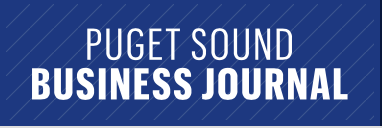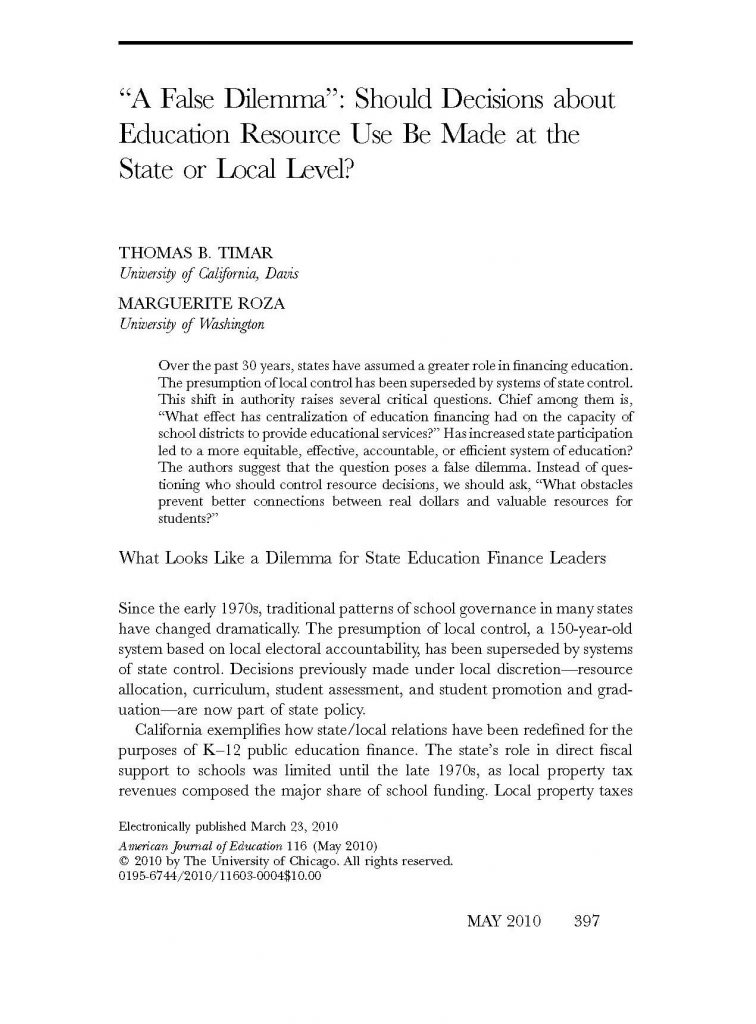Winding down ESSER. Is it working? What’s left to do?
Just 6 months remain on this massive federal program. While there’s still work to be done, we can already see it’s legacy taking shape. Here are a few highlights…
Bringing communities along during painful budget choices
For leaders facing tight budgets, there are better and worse ways to handle the next several months.
Closing schools: How much money does it save, and is it worth it?
School closure decisions are never easy. In this EdSource commentary, Roza and Dhammani outline several factors districts should consider in order to bring transparency to the process and ensure all students are served well.
School Boards Face Their Most Difficult Budget Season Ever

How can school board members bring their communities along in challenging financial times? Marguerite Roza and Laura Anderson weigh in at The 74.
Who decides what to cut? Technically school boards do
School boards face tough tradeoffs as they decide what to keep and what goes away when federal relief funds dry up. Here’s what we’ve been learning about how boards engage in making financial decisions.
30-Min Webinar: What happens to K-12 nonprofits and vendors when ESSER ends?

In this webinar we look at what nonprofits and vendors should know about the end of ESSER and market changes in the coming years.
30-Min Webinar: Mayday… Mayday… Who Will Answer the Distress Signals Appearing in Some Districts’ Data?

This webinar looks at ways to read the distress signals in district data, raise the alarm, and take steps to help “Mayday” districts.
30-Min Webinar: The ESSER Cliff: What state and district leaders in CT, MA, NH & RI should know as ESSER funding ends

This webinar shares an analysis of the pending ESSER cliff in districts in 4 New England states and key factors in protecting what matters most for students & district financial health.
Where and how does inequity creep in?

Marguerite Roza gave this presentation as part of panel on “Understanding Educational Opportunity Gaps,” at the University of Virginia School of Law’s launch of the Education Rights Institute.
The Grid: A Framework to Explore Budgeting Choices
This tool helps school, district, and state leaders strategically weigh investments by calculating per-student costs and spelling out desired results, risks involved, and how effectiveness will be measured.
30-Min Webinar: Districts now have more staff than ever. And fewer students. What happens next?

With the end of ESSER looming, and tighter state budgets, districts know they can’t afford their expanded labor force. Is now the time to rethink the age-old strategy that the best way to serve students is to add more staff?
Educators Beware: As budget cuts loom, now is NOT the time to quit your job

The staffing-enrollment mismatch spells financial trouble for school districts, and an end to the hiring spree of the last few years, write Katie Silberstein and Marguerite Roza at The 74.
A Guide for SEA-led Resource Allocation Reviews
Resource allocation reviews (RARs) in districts that serve low-performing schools offer a new opportunity to examine the connection between resource allocation and academic outcomes. We’ve created guidance documents, templates, and tips to help SEAs prepare for and conduct RARs.
30-Min Webinar: Make it or break it! This spring’s district budget choices matter tremendously for the years ahead.

Never before have district leaders faced such competing priorities: spend down relief dollars in ways that bring value for students, while also bracing for budget gaps unlike any in history. In this webinar we share what we’re seeing in district balance sheets, and outline key issues for this spring’s budget discussions.
The Stakes Are Only Getting Higher For Pandemic School Aid Spending

Higher spending in the final months of ESSER makes for deeper cuts come the 2024-25 school year, writes Marguerite Roza in Forbes. Meanwhile, students are still far behind where they should be.
Federal Data: Schools Have Been Adding Teachers Even As They Serve Fewer Students

For schools to improve their services and respond to student needs, it’s important to be precise about the exact staffing challenges they face, writes Chad Aldeman at The 74.
Districts play a starring role in school finance
For decades, the field of education finance has focused heavily on states (revenues, funding formulas). Now that attention is shifting to school districts’ spending choices, especially regarding federal ESSER funds.
30-Min Webinar: Is it too late for districts to redirect ESSER commitments to tackle learning gaps?

The school year had already started when test scores emerged showing deep gaps in learning. Is it too late for districts to adjust their ESSER commitments to boost recovery efforts? In this webinar we share our latest look at ESSER spending and suggest ways that districts can redirect, and in some cases refocus, their federal relief funds to respond to emerging data on what students need most.
Time to Change the District Budget Dance

Getting maximum value from available dollars is imperative, and may require some changes to the traditional budget process, writes Marguerite Roza in School Business Affairs Magazine.
On a Per-Student Basis, School Staffing Levels Are Hitting All-Time Highs

Schools in 46 states effectively lowered their teacher-student ratios by continuing to hire while enrollment has dropped, writes Chad Aldeman at The 74.
Financial Innovations During COVID Show Schools Can Be Nimble When They Have To

When districts break out of deeply ingrained expenditure habits, it’s a big deal. At The 74, Roza & Silberstein share four financial practices that emerged during the pandemic that we hope will last.
30-Min Webinar: The financial forecast is in! School district budgets are headed for a wild ride.

School district budgets are about to be hit by a powerful wave of financial pressures. In this webinar we walk through a mix of factors, explain how – and when – they’re likely to hit district budgets, and discuss how district and state leaders can make smart decisions now to prepare.
ESSER is fueling one-size-fits-all strategies. Let’s use data to deliver more targeted efforts.

The pandemic left schools with mammoth challenges. Using data to zero in on problem hotspots makes tackling them much more manageable. That should happen now, write Marguerite Roza and Ellie Roza, while federal relief money is still on the table.
30-Min Webinar: How can districts measure learning loss recovery costs?

In this webinar we share “The Calculator,” a new tool that estimates lost learning time in more than 8,000 school districts and how much a district would need to invest to get students back on track.
New Learning Loss Calculator Estimates COVID Slide, Costs of Catching Kids Up, in 8,000 School Districts

The Edunomics Lab team used the results from new research to build a calculator tool that estimates lost learning time in more than 8,000 school districts and what it will cost to get students back on track. In this commentary published by The 74, the authors urge district leaders to take stock of where their students are, and invest federal relief dollars now in ways that work for students.
Opinion: The N.Y. Legislature’s big class size mistake

In this New York Daily News op ed, Chad Aldeman argues that across-the-board class size caps in New York City may not benefit all students and will limit other spending that might be more effective, for example on extracurriculars or counselors or higher salaries for teachers.
Do districts need new budget moves?
It’s that time of year, the last step in what we call “The Budget Dance,” where school boards vote on a spreadsheet that officially becomes next year’s spending plan. What steps are missing in the process?
What Are Districts Using Their Federal Relief Money for? How Fast Are They Spending It? How Much Is Left? New Interactive Database Has Answers

Because Congress directed federal relief funds to flow through states, districts file for reimbursement as the funds go out the door. In an analysis published by The 74, the Edunomics Lab team shares early results of tracking the actual spending data, district by district.
There Is No ‘Big Quit’ in K-12 Education. But Schools Have Specific Labor Challenges That Need Targeted Solutions

There is no ‘Big Quit’ in K-12 education. But schools have specific labor challenges that need targeted solutions, writes Chad Aldeman in The 74.
30-Min Webinar: Will We Ever Know How ESSER Is Being Spent?

In this webinar we look at how federal relief money is being tracked and what we’re learning as a result.
Existing Federal Provisions Can – If Given Appropriate Attention – Advance Within-District Financial Equity

Four existing federal provisions have potential, if made a priority, to work together to foster within-district financial equity, write Marguerite Roza and Hannah Jarmolowski.
Districts Like San Diego Could Be Locking Themselves Into Painful Cuts Down the Road

Rather than making long-term commitments that can lead to financial stress down the road, Chad Aldeman suggests there are other ways for districts to both raise pay and build capacity.
Maintenance of Equity: A New Provision with Big Implications for District Budgeting

Chad Aldeman and Marguerite Roza explain how an expansive interpretation of a new federal provision could have unintended consequences.
What will MoEquity mean for district budgets?

In this webinar Marguerite Roza and Chad Aldeman discuss the new guidance for the maintenance of equity provision and what it would mean for districts faced with implementing it.
Communication Template for Principals on Use of Federal Relief Funds

Based on messaging research on how district staff, principals, teachers, and parents engage with and react to information about school finance, this template will help principals engage their community in a way that cultivates trust and helps make the most of the federal relief dollars.
Teacher Dissatisfaction May Be High, But So Are Retention Rates

Across Washington state, public schools retained a higher percentage of teachers last year than they do in normal years. That’s important information for school district leaders as they decide how to spend the windfall of federal relief funds headed their way.
By Paying Stipends to Schools’ Teaching Staff, Districts Can Add Learning Time Without Breaking the Bank

In this commentary at The 74, Chad Aldeman shows how offering current teachers stipends to take on more hours could provide students with additional learning time without locking districts into long-term financial obligations.
30-Min Webinar: Teacher Labor Market Trends and What They Mean For District Budgets

In this webinar, we share what we’re learning from the data on teacher turnover and discuss how the current fiscal conditions should inform staffing and salaries as districts navigate budget and hiring season.
School Spending Data: A New National Data Archive

This paper introduces a new national data archive that will capture year-over-year school-by-school spending figures reported by each state and enable easier cost-benefit analysis and new research on equity, innovation, and productivity at the school level.
Analysis: California Gives Districts Extra Money for Highest-Needs Students. But It Doesn’t Always Get to the Highest-Needs Schools

In this analysis, Katie Silberstein and Marguerite Roza studied whether funds allocated by California’s Local Control Funding Formula actually made it to the highest-needs schools.
New Financial Data Spotlight the District Role in Distributing Dollars Across Schools

In this Education Next article, Marguerite Roza and Laura Anderson share what we’re learning from early explorations of the data and the opportunities it provides for education leaders.
The Big Bet on Adding Staff to Improve Schools Is Breaking the Bank

By going all-in on staffing, we’ve crowded out other potential investments that can positively impact student learning. In this paper, Marguerite Roza writes that competing strategies should be viewed through the lens of which can do the most for students with the limited dollars at hand.
The “Would You Rather?” Test
Education spending always involves choices, and smart choices require understanding value for the dollar. This paper uses the “would you rather” exercise to explore tradeoffs in school spending and think through the value of various cost-equivalent investments.
Webinar: The Changing Role of Education Finance Leadership

This webinar explores connections and opportunities with ESSA’s financial transparency requirement, the new Supplement-not-Supplant requirement for a district “resource allocation methodology” and “resource allocation reviews,” and what each means for states and districts.
Weighted Student Funding Is On The Rise. Here’s What We Are Learning

In this blog, Marguerite Roza discusses initial findings from our IES-funded research study that seeks to document the range of WSF formulas and detail how they are being implemented in school systems around the nation.
New Education Department guidance on supplement-not-supplant: Sorry not sorry

In this Brookings Chalkboard blog post, Marguerite Roza discusses new U.S. Department of Education guidance on monitoring the “supplement-not-supplant” (SNS) provision of Title I.
Dear districts: These are the glory days. Are you ready for tomorrow’s financial pain?

In this commentary, Marguerite Roza writes that districts have a chance to strategically prepare for the inevitable economic downturn by reducing recurring costs and resisting more hiring; shifting budget choices to schools, allowing them to protect what matters most; and building trust around money and engaging community in tradeoffs.
Webinar: An Introduction to Student-Based Allocation

Designed for district and community leaders, this webinar shares how student-based allocation (SBA) works, why districts use SBA, what SBA formulas look like, and what steps and resources districts can take and tap to move toward SBA.
Taking stock of California’s weighted student funding overhaul: What have districts done with their spending flexibility?

In 2013 California adopted the Local Control Funding Formula (LCFF) to drive more resources to students with higher needs, create more spending flexibility, and let districts decide how to spend substantial new dollars. Our analysis examines financial data from nearly all California school systems to clarify how their spending choices changed in the first three years of the new state funding law.
Did districts concentrate new state money on highest-needs schools? Answer: Depends on the district.

Our analysis of eight districts takes a first look at whether CA districts did, under LCFF, allocate a larger share of their new funds to their highest-needs schools.
California’s weighted student funding formula: Does it help money matter more?

As California’s LCFF enters Year 5 of implementation, this brief analyzes whether we are seeing an improved relationship between spending and outcomes.
Analyzing early impacts of California’s Local Control Funding Formula

In 2013, California adopted the Local Control Funding Formula, shifting control over spending decisions from the state legislature to local school districts and eliminating many state-imposed spending rules. This three-part series analyzes early impacts of the LCFF, one of the nation’s largest weighted student funding (WSF) overhauls to date.
Webinar: What does the ESSA financial transparency requirement mean for districts?

This webinar provides an overview of the financial transparency requirement in the Every Student Succeeds Act, highlight lessons learned from states working toward meeting the requirement, and provide a district lens for thinking about the opportunities this new data can provide.
Productivity Improvements Paper Series

These five Rapid Response briefs model the costs of productivity improvements in K-12 education, including changes in staffing ratios, the impact of late-career teacher pay raises on pension debt, and paying the best teachers more to teach more students.
The Equity Problem in Teacher Pensions

This brief shows how high-minority schools receive fewer dollars in pension wealth than low-minority schools within the same district, and makes the case for pension dollars to be more transparent and included in discussions around K-12 spending equity.
Breaking tradition: A fixed-dollar pay raise strategy that benefits teachers and school districts

In this paper we examine both the degree to which pay systems for teachers are more heavily back-loaded than for many other professions and the ramifications of this steep salary curve for teachers, states and school districts.
How the teacher pay raise formula could worsen Seattle’s inequity

In this oped Marguerite Roza describes one critical issue underlying the fall 2015 Seattle Public Schools teachers’ strike that neither the Seattle School District nor the Seattle Education Association.
Turning a Benefits Conundrum into a Potential Opportunity for Teachers and Students

This analysis shows how a longer work year could increase teachers’ annual salaries and improve student outcomes.
Title I: Time to Get It Right

In this brief on the landmark federal law’s 50th anniversary, we offer five key principles to help policymakers revise Title I so that it fulfills its promise of augmenting funding for poor students.
Paying the Best Teachers More to Teach More Students

In this analysis we find how allowing our best teachers to teach more students in lieu of hiring additional staff could offer significant teacher bonuses. Findings are modeled state-by-state.
How Late-Career Raises Drive Teacher-Pension Debt

In this paper we model the impacts of late-term raises on teacher pension obligations showing that on average each dollar raise triggers $10 to $16 in new taxpayer obligations and provide suggestions to mitigate such impacts while improving incentives for early and mid career teachers.
Can decentralization improve Seattle schools?

In this op-ed, we argue that when the district decides what positions to fund in a school—rather than the school being empowered to decide based on its community priorities—it destroys goodwill and trust in the school system.
Denver Public Schools: Making More Money Follow Students

This two-page brief outlines how Denver Public Schools has steadily increased the amount of district funds funneled through the student based allocation formula the school system adopted in 2008. In fiscal 2014, the district allocated $3235 million, or approximately 38 percent, of its $865 million budget.
What Portion of District Funds Follow Students?

Part of our ongoing study of budgets in systems implementing student based allocation, in this four-page brief we analyze 12 district budgets and find that the systems allocate roughly 24 to 42 percent of their funds through an SBA formula.
Boston Public Schools: Weighting What Matters

In this three-page brief, we analyze the share of district dollars Boston Public Schools funneled through its student based allocation formula, adopted in 2012. In fiscal 2014, the district allocated $3235 million, or approximately 38 percent, of its $865 million budget through the formula.
How much money follows the student in WSF (aka SBA) districts?

In this presentation at the annual Association for Education Finance and Policy conference, we share our findings that the percent of total funds allocated via student based allocation (%SBA) ranges from a low of 23 percent to a high of 45 percent among ten urban school districts studied.
Rethinking Class Size to Expand Access to Best Teachers and Raise Pay

In this presentation at the annual Association for Education Finance and Policy conference, we share our exploration and cost modeling of cost-neutral options to raise teacher pay and give more students access to the best teachers.
Taking Off the Heat

On January 29, 2014 Marguerite Roza shared risks and rewards that emerge when districts “decentralize” engagement around financial decisions to the school level with Portfolio School District Network members in Houston, TX.
VisionSBA: K-12 Financial Modeling Tool

VisionSBA provides education leaders with a unique outlook on spending by school level within a district, delivering insight into relative spending across schools adjusted for each school’s actual mix of students. This interactive tool developed by Marguerite Roza and Jim Simpkins answers the question: “How much does each school spend relative to all other schools in this district taking into account its particular mix of students?”
The Case Against High School Sports

In this article published by The Atlantic, author Amanda Ripley draws on Marguerite Roza’s research as she describes the role of high school sports in the American education system, how current resource allocations favor sports over academics, and consequences as American students fall behind in international rankings.
Funding Phantom Students

This brief describes a common practice that inhibits both efficiency and productivity: funding students who do not actually attend school in funded districts and how this is often overlooked by state leaders.
How Current Education Governance Distorts Financial Decisionmaking

In this chapter, Roza assesses the strengths and weaknesses of what remains of the old in education governance, scrutinizes how traditional governance forms are changing, and suggests how governing arrangements might be further altered to produce better educational outcomes for children.
Student-Based Allocation to Enable School Choice

This brief explains the need for student-based allocation to enable student choice and portable funding across schools within districts.
What Happens to Teacher Salaries During a Recession?

This study uses data from Seattle Public Schools to explore actual salary changes amidst rapid changes in economic context and the effect of the recession on teacher pay.
Q&A on the Chicago Teachers Contract Math

This brief examines the real numbers on the Chicago teachers contract costs.
Chicago Teacher Salaries in the Regional Chicago Context

This brief examines how Chicago teacher salaries compare in regional and national contexts.
The Promise of Cafeteria-Style Benefits for Districts and Teachers

While typical school district plans offer a one-size-fits-all package of benefits to employees, cafeteria plans allow employees to customize their benefits within a given cost, an option districts may want to consider.
A False Dilemma: Should Decisions About Education Resource Use Be Made at the State or Local Level?

The shift in authority from the local to the state level raises several critical questions. In this paper, the authors suggest that the question should be “What obstacles prevent better connections between real dollars and valuable resources for students?”
Beyond Teacher Reassignments: Better Ways Districts Can Remedy Salary Inequities Across Schools

This brief demonstrates how, contrary to common worry, closing Title I’s “comparability provision” loophole would not force districts to mandatorily reassign teachers.
Now is a Great Time to Compute the Per-Unit Cost of Everything in Education

This paper examines how calculating the per unit costs of what schools or districts can deliver can provide the best insight into the implications of all that spending.
Seniority-Based Layoffs Will Exacerbate Job Loss in Public Education

This brief details why K-12 school districts that lay off personnel according to seniority cause disproportionate damage to their programs and students than if layoffs were determined on a seniority-neutral basis.
Understanding Student-Weighted Allocation as a Means to Greater School Resource Equity

This study examines Houston ISD and Cincinnati Public Schools, providing evidence that student-weighted allocation can be a means toward greater resource equity among schools within districts.
How Districts Shortchange Low-Income and Minority Students

Dr. Roza’s analysis demonstrates that, despite district bookkeeping practices that make funding across schools within the same district appear relatively comparable, substantially less money is spent in high-poverty and high-minority schools.
Pennywise and Pound Foolish in Education
The authors suggest that weighed student funding would show exactly where the money is going and foster transparency and accountability for performance, thereby potentially closing the gaps in local public service quality between the privileged and the disadvantaged.
A Cost Allocation Model for Shared District Resources: A Means for Comparing Spending Across Schools
It can be difficult to assess how resources are distributed between schools, and whether every school is afforded the same opportunities to meet its educational goals. This paper addresses one key driver of spending variation between schools: shared district resources.
Leveling the Playing Field: Creating Funding Equity Through Student-Based Budgeting
This report traces Cincinnati Public Schools’ process of moving to a system of student based budgeting: funding children rather than staff members, and weighting the funding according to schools and students’ needs.
Reading District Budget Packets
This activity guides participants through reading and understanding district budgets.

